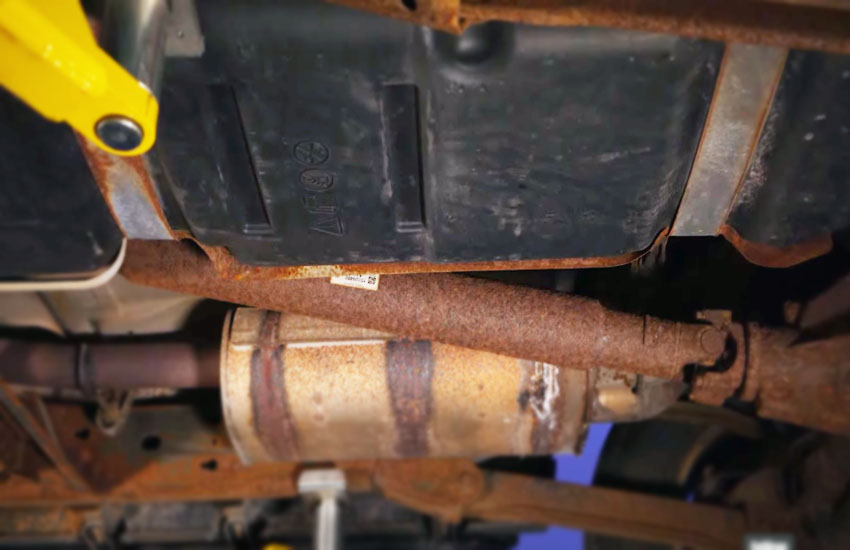Have you been driving around in your 2004 Ford Sport Trac with a fuel gauge that’s either stuck on empty or full? That annoying issue of a malfunctioning fuel gauge can leave you guessing how much fuel is left in your tank. But don’t worry; this is a more common problem than you might think, and the good news is that it’s usually fixable. In this ultimate guide, we’ll break down everything you need to know about fixing your 2004 Ford Sport Trac’s fuel gauge. Whether it’s a simple fuse issue or a more complex wiring problem, we’ve got you covered.

Understanding the Fuel Gauge System in the 2004 Ford Sport Trac
Before diving into troubleshooting, it’s important to understand how the fuel gauge system works in your 2004 Ford Sport Trac. The fuel gauge is an electrical system that uses a combination of sensors, wires, and displays to tell you how much gas is in your tank. When everything works correctly, the sending unit inside your fuel tank sends signals to the fuel gauge on your dashboard, which moves the needle to the correct position.
In the 2004 Ford Sport Trac, the system works via a sending unit that consists of a float (like a small plastic ball) that moves up and down based on the level of fuel in the tank. This float is attached to a variable resistor, which changes the electrical resistance depending on the float’s position. The system then sends this signal to the gauge, and voilà – you see the fuel level displayed on the dashboard.
However, this system can have issues, and it can fail at various points, leading to an inaccurate or non-functioning fuel gauge. So, let’s break down the possible causes of a malfunction and how you can fix them.
Common Reasons Why the Fuel Gauge Isn’t Working in the 2004 Ford Sport Trac
If your 2004 Ford Sport Trac’s fuel gauge isn’t working properly, there could be a few culprits behind it. Some of the most common reasons include faulty sending units, wiring issues, or a blown fuse. Let’s take a deeper look at each one of these causes.
Faulty Sending Unit
The sending unit inside the fuel tank is responsible for measuring the level of fuel and sending the corresponding signal to the fuel gauge. If the sending unit malfunctions, the gauge will display incorrect readings or may not work at all. Over time, sending units can wear out due to factors like corrosion, dirt, or wear on the float mechanism. A faulty sending unit is one of the most common reasons for a non-working fuel gauge.
Electrical Wiring Issues
Another potential cause of a malfunctioning fuel gauge is a problem with the electrical wiring that connects the sending unit to the gauge. If the wiring becomes loose, corroded, or damaged, the electrical signals may not properly reach the gauge, resulting in a stuck or inaccurate needle.
Blown Fuse
The fuel gauge system in the 2004 Ford Sport Trac is protected by a fuse. If the fuse blows, the gauge will stop working altogether. A blown fuse can be caused by an electrical surge, a short circuit, or simply a faulty fuse that has reached the end of its lifespan.
Faulty Fuel Gauge
If all the wiring and sending unit are functioning correctly, the problem might lie with the fuel gauge itself. While this is less common, it’s still a possibility. If the gauge is broken or malfunctioning, it may need to be replaced.
Malfunctioning Fuel Tank Float
The float in the sending unit is another potential point of failure. If the float becomes stuck, corroded, or damaged, it can fail to detect the fuel level properly. This can result in the fuel gauge showing an inaccurate reading.
Poor Grounding Connections
A poor ground connection can interfere with the fuel gauge system. If the ground wires in your 2004 Ford Sport Trac are loose or corroded, it can cause all sorts of electrical problems, including issues with the fuel gauge.
How to Troubleshoot and Fix the Fuel Gauge in Your 2004 Ford Sport Trac
If your fuel gauge is giving you trouble, don’t panic! There are several troubleshooting steps you can take to determine the cause of the issue and, in many cases, fix it yourself. Here’s how you can troubleshoot the problem in your 2004 Ford Sport Trac.
Step 1: Inspect the Fuse
The first thing to check when the fuel gauge isn’t working is the fuse. If the fuse blows, the gauge will stop functioning entirely. To inspect the fuse:
- Turn off your car and locate the fuse box. In the 2004 Ford Sport Trac, the fuse box is typically located under the dashboard or near the driver’s side of the engine bay.
- Find the fuse that corresponds to the fuel gauge (it may be labeled “Fuel” or “Instrument Cluster”).
- Use a fuse puller or small pair of pliers to remove the fuse.
- Inspect the fuse for any visible damage. If the metal inside the fuse is broken, it’s blown.
- Replace the fuse with one of the same amperage (usually printed on the fuse itself).
- Turn the car back on and check the fuel gauge.
If replacing the fuse doesn’t fix the issue, move on to the next troubleshooting steps.
Step 2: Check the Sending Unit
If the fuse is working but the gauge still isn’t reading correctly, the next step is to check the sending unit. The sending unit is located inside the fuel tank, so it can be a little more difficult to access. Here’s what to do:
- Make sure the fuel tank is low or nearly empty to reduce the risk of fuel spillage.
- Depending on your 2004 Ford Sport Trac model, you may need to remove the rear seat or access the fuel tank from the bed of the truck.
- Once you locate the sending unit, inspect it for visible signs of wear, corrosion, or damage. Pay special attention to the float and the wiring attached to it.
- If the sending unit looks damaged or corroded, it will need to be replaced.
Step 3: Inspect the Wiring
If the fuse and sending unit seem fine, the issue might lie with the wiring. Over time, wiring can become loose, corroded, or damaged, preventing the proper electrical signal from reaching the fuel gauge. Check the wiring from the sending unit to the gauge to make sure everything is intact.
- Look for any loose or corroded connections.
- Check for any visible signs of wear, like frayed wires or exposed wiring.
- If you find damaged wiring, repair or replace it as needed.
Step 4: Test the Fuel Gauge
If everything seems to be working fine with the fuse, sending unit, and wiring, but the fuel gauge still isn’t functioning, the problem might be with the gauge itself. To test the fuel gauge, you can try using a multimeter to measure the electrical signals being sent to the gauge. If the signals are fine, but the needle still isn’t moving, it’s time to replace the gauge.
Step 5: Replace the Fuel Gauge
Replacing the fuel gauge is a more involved process, as it requires removing the instrument cluster from the dashboard. If you’re comfortable with DIY repairs, follow these steps:
- Use a screwdriver to remove the screws or clips holding the instrument cluster in place.
- Gently pull the cluster out from the dashboard, making sure not to damage any wires or connectors.
- Disconnect the wiring from the back of the cluster.
- Remove the old fuel gauge and install the new one.
- Reassemble the cluster and reinstall it in the dashboard.
- Turn on the car and check if the fuel gauge is working.
Preventing Fuel Gauge Issues in Your 2004 Ford Sport Trac
To avoid running into fuel gauge problems in the future, regular maintenance and care are key. Here are a few tips to keep your fuel gauge in top shape:
Regular Inspections
Inspect your fuel system regularly, including the sending unit, float, wiring, and fuse. Catching small issues before they become bigger problems can save you time and money.
Avoid Running on Empty
Try not to let your gas tank get too low, as this can put unnecessary stress on the sending unit and float. Keeping your tank at least a quarter full can help prolong the life of the fuel gauge system.
Keep an Eye on Electrical Components
Electrical issues can affect your fuel gauge, so make sure all connections are clean and secure. If you notice any corrosion on the wiring, take care of it before it causes more problems.
I hope this guide helps you get your 2004 Ford Sport Trac’s fuel gauge back in working order! Whether it’s a simple fuse replacement, a faulty sending unit, or a wiring issue, there are plenty of ways to troubleshoot and fix the problem. With a little patience and some basic tools, you’ll be back on the road with an accurate fuel gauge in no time.

Frequently Asked Questions
Is it possible for a blown fuse to stop the fuel gauge from working?
Yes, a blown fuse can prevent the fuel gauge from receiving power, causing it to stop working. Replacing the fuse is an easy first step in troubleshooting the issue.
Can a faulty sending unit cause the fuel gauge needle to stay stuck?
Yes, a faulty sending unit can cause the fuel gauge needle to get stuck or show incorrect readings. If the sending unit is damaged, it will need to be replaced.
Do I need to remove the fuel tank to replace the sending unit in the 2004 Ford Sport Trac?
In most cases, yes. The sending unit is located inside the fuel tank, so it must be accessed by removing the seat or bed of the truck.
Is it safe to drive with a malfunctioning fuel gauge?
While it’s not ideal to drive with a malfunctioning fuel gauge, it’s generally safe as long as you monitor your fuel levels closely and don’t run out of gas.
Can damaged wiring cause the fuel gauge to malfunction?
Yes, damaged or corroded wiring can interrupt the electrical signal between the sending unit and the fuel gauge, causing it to malfunction or give inaccurate readings.
Do I need special tools to replace the fuel gauge in the 2004 Ford Sport Trac?
Replacing the fuel gauge may require basic tools such as screwdrivers, a multimeter, and possibly a fuse puller. If you’re uncomfortable with the procedure, a mechanic can handle it for you.
Can a faulty fuel gauge be repaired without replacing the entire instrument cluster?
In some cases, it’s possible to fix the fuel gauge without replacing the entire instrument cluster. However, if the gauge itself is damaged, it may need to be replaced.
Is it possible to fix the fuel gauge problem myself, or should I take it to a mechanic?
If you’re comfortable with DIY repairs and have basic tools, many fuel gauge issues can be fixed yourself. However, if you’re unsure or the problem is more complex, it’s best to consult a professional.
